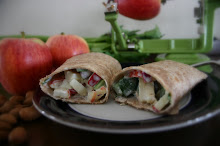
Sprouting grain really is simple once you get the hang of it.
Step 1. Fill a glass bowl with wheat, spelt, or kamut and cover with filtered water. Let it sit for 8-10 hours.

Step 2. Dump it into a stainless steel colander, cover with a damp cloth, and set in a warm place.

Step 3. Rinse once a day, and in a day or two, you should see cute, little tails growing.

How simple is that? Once you get the hang of it, you can make large batches at a time. The sprouted grain can then be dehydrated for preservation, and then run through your wheat grinder to use in place of other flours in your cooking as needed.










How often do you sprout your grains? What kind of dehydrator do you use?
ReplyDeleteMichele,
ReplyDeleteThank you for your comment. About once a month, I sprout a big batch of grain. After it's dehydrated, I store it in a large container in my pantry. You can store it in your fridge for longer storage, but the pantry works fine if you're low on fridge space.
The kind of dehydrator that I use is a circular Nesco one. I have several racks with the plastic mesh liners that I use for dehydrating. When it's done dehydrating, I dump the grain into a big stainless steel bowl, then I scoop it into my containers and store.
Thanks again for your comment.
I just bought your book and I am very intrested in learning how to sprout wheat. I have several questions. How much flour do you get out of one batch? And how long does it last in the pantry? Can you use the sprouted wheat for recipes without dehydrating it? If so, how long does it last and where do you store it? Can you use the sprouted wheat in dough recipes without dehydrating it? Can you grind the sprouted wheat for recipes without dehydrating it?
ReplyDeleteThanks,
Chrissy
Chrissy,
ReplyDeleteThank you for your post. I'll try to answer your questions the best I can.
First, how much flour I get out of a batch depends on how big a batch is. When I sprout, I do big batches about once a month by nearly filling a 6 quart stainless steel bowl with wheat, soaking it in filtered water for about 12 hours, pouring the contents into two colanders (preferably stainless steel), sprouting for about 24 hours, then dehydrating it for 12 hours. 12-24-12. This yields a little more than 6 quarts of sprouted wheat berries. Each cup of wheat that I run through my wheat grinder yields a little more than a cup of flour.
Dehydrated wheat berries keep in the pantry for several months, but keep longer in the fridge. I usually go through mine in a month so storage time isn't an issue for me.
Yes, you can use sprouted wheat in recipes without dehydrating them first. There are several in the cookbook. You will need a good heavy-duty food processor or blender that will be able to blend them well. If you have a nice food processor with a sharp blade, you can take the sprouted, still moist wheat berries and process them into a ball of dough, then add in the other ingredients like sea salt, eggs, a little oil, etc. shape the dough into cinnamon rolls, French bread or whatever, then bake. Some recipes are the Yeast-Free Flourless Bread on pg. 72, Flourless Biscuits on pg. 73, Yeast-Free Breadsticks on pg. 76, Pumpernickel Bread and English Muffins on pg. 78, Basic Sweet Muffins on pg. 80, Raisin Cinnamon Bread on pg. 82, or click on the picture on this blog, and Flourless Cinnamon Rolls on pg. 84. You can also make pancakes out of them by adding milk, eggs, sea salt, oil, etc. along with the sprouts, and blend really well.
When I make recipes with moist sprouts, I use them right away, then dehydrate whatever is left over. But they can be kept in the fridge for about a week. (They still grow in the fridge, just at a slower rate.)
The only way to use sprouted wheat in dough recipes without dehydrating is by running them in a good food processor as mentioned above. If you try to grind them (in a wheat grinder) before dehydration it'll likely ruin the grinder.
Another thing you could do is sour. This is easy because it involves no sprouting. Just fresh non-sprouted whole-wheat flour and liquid with a little souring agent like lemon juice, whey, or raw apple cider vinegar. Stir together, set on your counter for 24 hours covered with a damp cloth, and then add other ingredients to make pancakes or sourdough bread or pizza crust. The sourdough pancake recipe on this blog shows you how.
Thanks again for your comment and for these great questions. If you have any other questions, feel free to ask. J
Jillayne
Jillayne,
ReplyDeleteThank you for answering my questions.That really helps. I hope you don't mind but I have a few more questions. Can you fit 6 quarts of sprouted wheat in your dehydrator? Also, for souring how much liquid and souring agent do you add to the flour? Are you trying to form a dough ball or just pour the liquid over the flour? And can you use the soured flour in place of sprouted flour in all recipes. And can you sour beans, lentils, quinoa, etc instead of sprouting? Sorry, I am very new at all of this. Thanks for your help.
Chrissy
Chrissy,
ReplyDeleteYou're welcome!
Yes, I can fit 6 quarts of sprouted grain in my dehydrator at a time. I just pack it in there so that the grain usually touches the top of the next tray. I use up 11-12 mesh lined trays on a Nesco dehydrator and it takes about 12 hours at 145 degrees to dry them completely.
When souring, if you are making bread or dough, the liquid you add is half or less than half of the amount of flour used, depending on the recipe. After mixing the flour/water/souring agent, the dough should be stiff. It softens as it sours, and then after 24 hours, and afer adding eggs/oil, and other things, it should be more the consistency of bread dough. There are some sourdough recipes in the cookbook. For pancakes you use equal amounts of liquid and flour and stir together to make a batter. Then cover with a damp cloth and set on counter for 24 hours. After this time, you add eggs, oil, sea salt, and baking soda, stir together then pour into pancakes on the griddle.
When you say soured flour, are you talking about souring flour then dehydrating it so you can substitute it for sprouted flour in recipes? I've never tried it but thought of doing so.
I have never tried souring beans, lentils, or quinoa instead of sprouting. I'm not sure how beans and lentils would taste. Quinoa might be alright.
All this info can all be quite intimidating at first. For me, I started just with making sourdough pancakes, then began experimenting with adding less liquid when souring to make things like muffins and breads. Then I got brave enough a little later to try sprouting, and made several batches of alcohol on accident because the jar method just didn't work for me. But when I found out about using a colandar, that was just so simple, and I haven't ever had bad batch. It turns out every time.
Good luck to you. I know you'll be successful!
Jillayne
Jillayne;
ReplyDeleteI love your book! Thanks to you and Michelle. I'm wondering about your gluten intolerance. I have been off gluten for just over a year because of allergy and now I'm wanting to try the sprouting and souring idea but I'm nervous! Did you go off of gluten before you experimented with sprouting or did you just go straight into using those methods without a period of abstaining? My hope of course is that after giving my insides a break, I might be able to slowly reintroduce gluten sprouted or soaked and be able to use all of the goodness of wheat again. Any thoughts you have would be appreciated! Thanks! Jacque
Jacque,
ReplyDeleteGreat question! I just went right ahead into trying sprouted grains without abstaining first. Then again, I only had gluten intolerance, not an allergy. If you have an actual allergy (your body attack even with minute amounts of gluten), I wouldn't eat any, just to be cautious. If it's an intolerance, you should be able to introduce it into your diet again using sprouted grains. I would be very moderate when reintroducing it into your diet, because overdoing it may cause intolerance again.
Thanks for reading the book, and good luck with your health!
~Jillayne
Hi Jillayne!
ReplyDeleteYour book was given to me for my birthday! I was diagnosed with celiac about 3 months ago. I have more of an intolerance.
I would like to try sprouting, but am a little nervous and this may be a dumb question, but do you just go buy white and brown rice and then sprout? Same with the grains? I'm just confused and didn't want to take my package of white rice that I bought at the grocery store and try it, if it's the wrong kind of rice.
Thanks,
Jennifer
Hi Jennifer,
ReplyDeleteThanks for your question! For sprouting rice, you will need to use brown rice since it has all its growing parts intact. All you need is brown rice in a bowl, fill it with water so that the water line is about an inch or more above the grains, and keep it in a warm place for about 24 hours. (I stick my bowl in my oven with only the light on, which creates a nice warm atmosphere.) I drain and rinse the rice once or twice a day until little tails start to grow. As far as other grains go, any whole grain (grain that hasn't been polished or chopped or steel cut) can sprout. The only grain I haven't successfully sprouted is oat groats. I think oats need to not be hulled in order to sprout, and I haven't bothered with it. I hope this helps, and I wish you the best of luck going gluten-free!
Jillayne